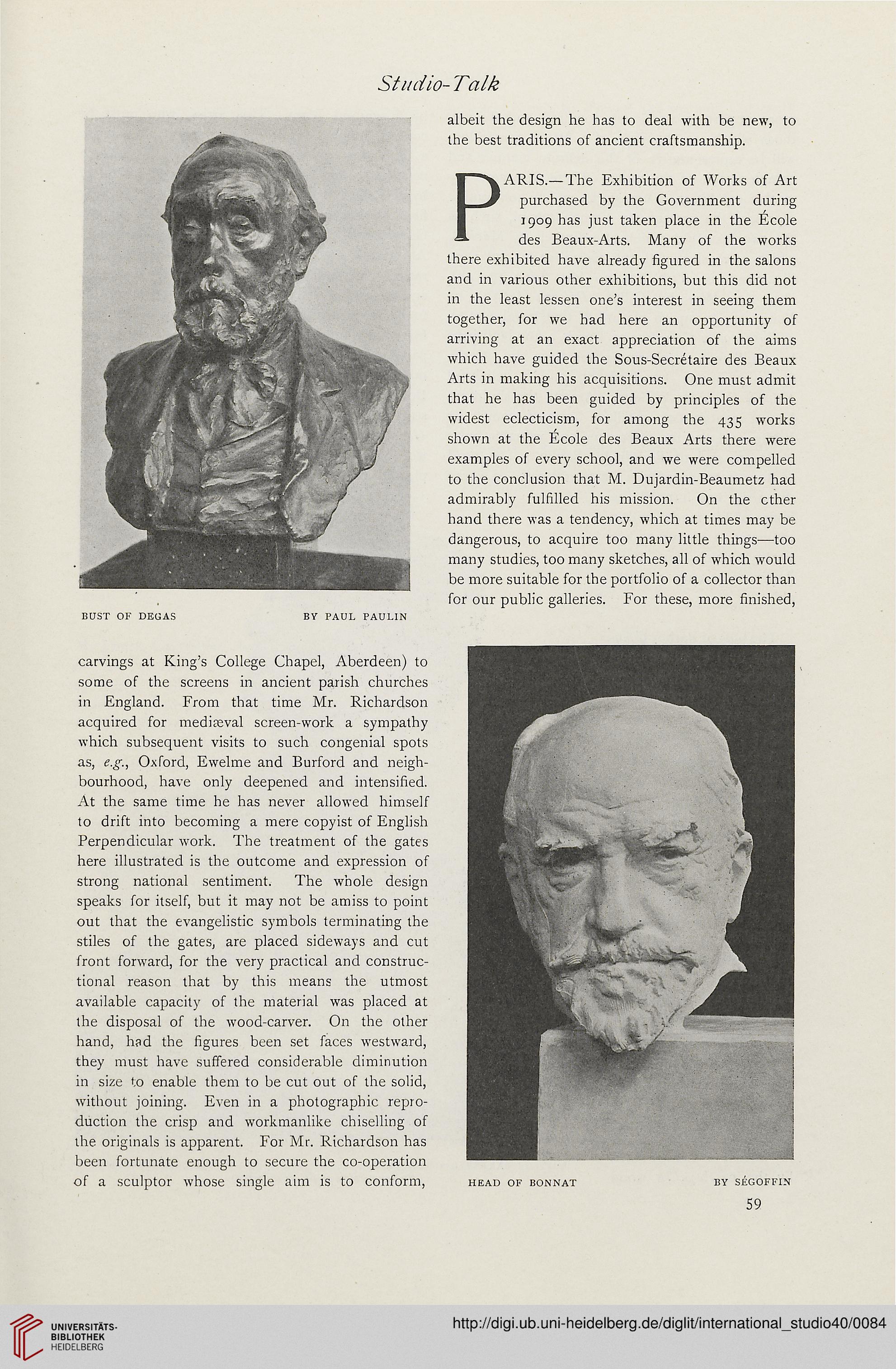Studio-Talk
BUST OF DEGAS BY PAUL PAULIN
carvings at King's College Chapel, Aberdeen) to
some of the screens in ancient parish churches
in England. From that time Mr. Richardson
acquired for mediaeval screen-work a sympathy
which subsequent visits to such congenial spots
as, e.g., Oxford, Ewelme and Burford and neigh-
bourhood, have only deepened and intensified.
At the same time he has never allowed himself
to drift into becoming a mere copyist of English
Perpendicular work. The treatment of the gates
here illustrated is the outcome and expression of
strong national sentiment. The whole design
speaks for itself, but it may not be amiss to point
out that the evangelistic symbols terminating the
stiles of the gates, are placed sideways and cut
front forward, for the very practical and construc-
tional reason that by this means the utmost
available capacity of the material was placed at
the disposal of the wood-carver. On the other
hand, had the figures been set faces westward,
they must have suffered considerable diminution
in size to enable them to be cut out of the solid,
without joining. Even in a photographic repro-
duction the crisp and workmanlike chiselling of
the originals is apparent. For Mr. Richardson has
been fortunate enough to secure the co-operation
of a sculptor whose single aim is to conform,
albeit the design he has to deal with be new, to
the best traditions of ancient craftsmanship.
PARIS.—The Exhibition of Works of Art
purchased by the Government during
1909 has just taken place in the Ecole
des Beaux-Arts. Many of the works
there exhibited have already figured in the salons
and in various other exhibitions, but this did not
in the least lessen one's interest in seeing them
together, for we had here an opportunity of
arriving at an exact appreciation of the aims
which have guided the Sous-Secretaire des Beaux
Arts in making his acquisitions. One must admit
that he has been guided by principles of the
widest eclecticism, for among the 435 works
shown at the Ecole des Beaux Arts there were
examples of every school, and we were compelled
to the conclusion that M. Dujardin-Beaumetz had
admirably fulfilled his mission. On the ether
hand there was a tendency, which at times may be
dangerous, to acquire too many little things—too
many studies, too many sketches, all of which would
be more suitable for the portfolio of a collector than
for our public galleries. For these, more finished,
BUST OF DEGAS BY PAUL PAULIN
carvings at King's College Chapel, Aberdeen) to
some of the screens in ancient parish churches
in England. From that time Mr. Richardson
acquired for mediaeval screen-work a sympathy
which subsequent visits to such congenial spots
as, e.g., Oxford, Ewelme and Burford and neigh-
bourhood, have only deepened and intensified.
At the same time he has never allowed himself
to drift into becoming a mere copyist of English
Perpendicular work. The treatment of the gates
here illustrated is the outcome and expression of
strong national sentiment. The whole design
speaks for itself, but it may not be amiss to point
out that the evangelistic symbols terminating the
stiles of the gates, are placed sideways and cut
front forward, for the very practical and construc-
tional reason that by this means the utmost
available capacity of the material was placed at
the disposal of the wood-carver. On the other
hand, had the figures been set faces westward,
they must have suffered considerable diminution
in size to enable them to be cut out of the solid,
without joining. Even in a photographic repro-
duction the crisp and workmanlike chiselling of
the originals is apparent. For Mr. Richardson has
been fortunate enough to secure the co-operation
of a sculptor whose single aim is to conform,
albeit the design he has to deal with be new, to
the best traditions of ancient craftsmanship.
PARIS.—The Exhibition of Works of Art
purchased by the Government during
1909 has just taken place in the Ecole
des Beaux-Arts. Many of the works
there exhibited have already figured in the salons
and in various other exhibitions, but this did not
in the least lessen one's interest in seeing them
together, for we had here an opportunity of
arriving at an exact appreciation of the aims
which have guided the Sous-Secretaire des Beaux
Arts in making his acquisitions. One must admit
that he has been guided by principles of the
widest eclecticism, for among the 435 works
shown at the Ecole des Beaux Arts there were
examples of every school, and we were compelled
to the conclusion that M. Dujardin-Beaumetz had
admirably fulfilled his mission. On the ether
hand there was a tendency, which at times may be
dangerous, to acquire too many little things—too
many studies, too many sketches, all of which would
be more suitable for the portfolio of a collector than
for our public galleries. For these, more finished,




